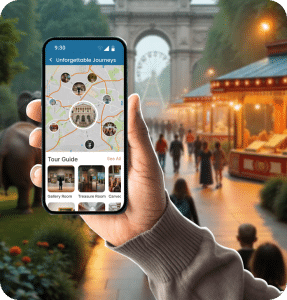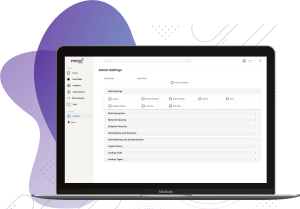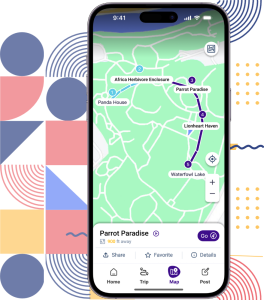Category: Collaboration

- Date: November 20, 2025
Fossil Rim App – Your Safari Experience
Introducing the Fossil Rim Visitor App Powered by Pigeon-Tech Fossil Rim Wildlife Center isn’t just a wildlife park – it’s a global conservation leader dedicated...

- Date: July 17, 2025
AZA’s Impact: Shaping the Future of Conservation
As the Association of Zoos and Aquariums (AZA) celebrates over a century of leadership, its impact on conservation, animal welfare, and public engagement is more...

- Date: June 23, 2025
Developed by Pigeon-Tech: The Freedom Journey App Brings America’s Underground...
Pigeon-Tech is honored to unveil the Freedom Journey App, an immersive digital experience developed in partnership with America’s River Roots, as part of the official...

- Date: June 20, 2025
America250: Make Every Celebration Count with Smart, Interactive Solutions!
If you’re organizing an event for America’s 250th anniversary, you know the challenge: how do you make history come alive for everyone—locals, visitors, and sponsors...

- Date: June 18, 2025
Advance Your Facility: ARPA Grants for Zoos and Aquariums.
The American Rescue Plan Act (ARPA) is not just another government program—it’s a lifeline and a launchpad for your institution. Through ARPA, unprecedented funding is...

- Date: June 9, 2025
Transform Every Visit with AI: The Future of Museums &...
The best attractions don’t just inform—they transform. With AI, every guest becomes the hero of their own adventure Imagine this:A family enters your museum, zoo,...

- Date: June 6, 2025
The Amazing New Way to Turn Every Visit Into an...
Imagine this: A family walks into your attraction. The kids are bouncing with excitement, and the parents are all curious and ready to explore. But...

- Date: May 19, 2025
AAM 2025 Highlights Museums as Tech-Driven, Trusted Institutions
How AAM 2025 Reinforced Museums as Tech-Ready, Trusted Institutions From May 6–9, Los Angeles became the epicenter of cultural innovation as over 4,000 museum professionals,...

- Date: April 14, 2025
Rethinking In-House App Development for Attractions: Why Pigeon Suite is...
As museums, zoos, aquariums, and theme parks continue to enhance their visitor experiences, many are considering the development of custom in-house apps. A well-designed app...

- Date: March 27, 2025
2025: The Year of Immersive Experiences in Attractions
As we enter 2025, attractions are pushing the boundaries of technology to create unforgettable experiences. From AI-driven interactions to futuristic travel, the industry is evolving...

- Date: March 18, 2025
How to Evaluate Mobile App Solutions for Your Theme Park,...
Discover exactly what to look for in a new technology partner, so you can make your purchase with confidence. Mobile apps have become an essential...

- Date: March 14, 2025
Unlocking Attractions: Insights from the Experience Economy
As we navigate the evolving landscape of the attractions industry, understanding the Experience Economy is crucial. B. Joseph Pine II and James H. Gilmore’s seminal...

- Date: February 25, 2025
Pigeon Suite’s “Animal or Exhibit Spotlight”: Enhancing Visitor Experiences in...
In today’s experience-driven world, Zoos, Aquariums, and Museums are constantly seeking innovative ways to captivate visitors and create lasting memories. Pigeon Tech’s “Animal Spotlight or...

- Date: July 2, 2024
Tech Transforms Zoos: From Fun to Conservation Action!
Zoos are no longer just about popcorn and selfies with penguins. Technology is revolutionizing how zoos educate visitors about the natural world, inspiring them to...

- Date: April 29, 2024
Transforming Small Museums with Digital Strategies: Why It’s Time to...
To all small museum directors, the question looms large: In a digital-first world, can we afford to overlook a digital strategy? Alejandra Garcia Bittar’s enlightening...

- Date: April 29, 2024
Elevate Your Golf facility with Pigeon-Tech
Introducing the latest innovation from Pigeon-Tech: a Golf Scoring App poised to revolutionize your golfing experience, whether you’re on the outdoor course or in the...

- Date: December 22, 2023
Data, Automation, and the Guest Experience: Navigating Challenges with Innovation...
In the dynamic world of visitor attractions, the fusion of data, automation, and technology stands as a beacon of progress, transforming challenges into opportunities. This...

- Date: December 6, 2023
Personalization and Data Analytics: Revolutionizing Guest Experiences in Hospitality
Explore how data analytics is transforming the hospitality industry by enabling personalized guest experiences. Dive into our insights on data collection, room customization, and tailored...

- Date: October 17, 2023
Unlocking the Potential of Zoos and Aquariums: Steps for Success
Discover simple ways zoos and aquariums can do better. Learn about teaming up with governments and getting funds to help their community and economy.

- Date: September 1, 2023
Top Technology Trends in the Attractions Industry – 2023
The trend of gamification or interactivity is making significant waves in the attractions industry's technological landscape. Theme parks are progressively integrating innovative technologies like augmented...